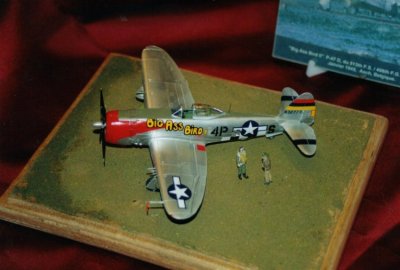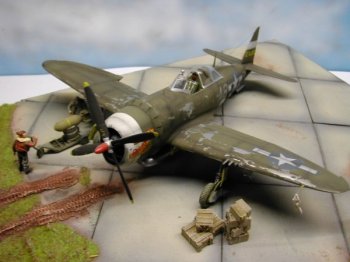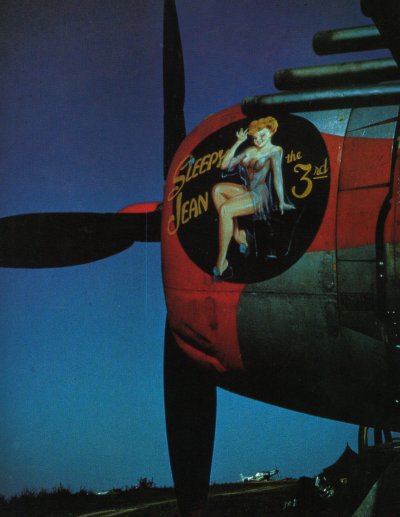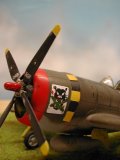T-BOLT SAGA

The reduce scaled P-47 TUNDERBOLT
When he was put into service, the P-47 Thunderbolt Dislike to his pilotes, who judged him excessively heavy & Gauche. His production numbers exceeded all the others american fighters numbers & the part he took in the victory is far from negligible.
Construct in the most important number than any other american aircraft since the dawn of aviation, the P-47 proceeded a diametraly opposed conception to the conception who lead soviet constructors to produce small & manoeuvrable aircrafts. Compared to the today fighters, the Thunderbolt is a small size aircraft, but 40 years ago, it was a true monste. The RAF pilots use to say that his pilot could avoid the ennemy fire by running in every direction inside its cockpit. There are many who, in 1943, had been astonished by its inflight weight, over 6 t, but how would they have reacted if they had known that, 3 years later, this same weight would have increase by more than 50 % ? So the Thunderbolt weighted more than a loaded Dornier Do 17 bomber. In 1940, the optimal weight problem concerning the fighters aircraft was far from being resolved by the US Army Air Corps. One of the main fighters constructor, the Republic Aviation Corporation (issued from the Seversky Aircraft), heritated however a tradition regarding the fighters with big star shaped engines, as well as wings & empennages of elliptic shapes. At that time, it was constructing the P-35, & was going to build the P-43 Lancer, equiped by a landing gear folding to the inside & moved by a turbocompresso Twin Wasp engine. Among the future Republic projects figurated the AP-4, designed to receive a R-2180 of 1 400 ch or a R-2800 Double Wasp of 1 850 ch, & the light fighter AP-10 moved by a fluid cooled Allison & armed only by 2 caliber .50 (12,7 mm) machine guns. The war already begun in Europe told that none of them had the specifications required, & on june 12 1940 the chief of the research & development office, Alex Kartveli, submit a much more ambitious idea which could determine an important technological advance. The Army Air Corps, then worrying, approved fast the project & give it the XP-47B designation (the XP-47 & XP-47A would have by prototypes issued of the AP-10 if this one had been created).
The design of the new fighter was a simple & pure challenge. The engine installation was so complex that Kartveli stated by its conception, to build around it the rest of the aircraft. The engine, an impressive R-2800 of 18 cylinders, was fed by a turbocompressor, which, for some reasons, including aerodynamicals, had to be install at the rear of the fuselage. The exhausts converged in 2 huge pipes which upstream was, in full power, reddish, & lead to the turbocompressor. There, a valvo of variable opening evacuated all the exhaust gas to the exterior, or, as the altitude increased, used some of it to drive the turbine. This turbine made turning at 60 000 tr/mn a centrifuge compressor which fed in fresh air the 18 cylinder via a pipe on which a pre cooling device increase the air density, increasing the power. This wing position caused many problems to Kartveli. The great power of the engine involve a wide diameter propeller, & even with one of the new Curtiss constant speed quadriblade, this diameter could not be less than 3,71 m. To give the necessary height to soil for take off, the landing gear struts had to been as long as the wing was located over the bottom of the fuselage & they had to get a precise dihedron. All this had many inconveniences : the landing gear could only have the required solidity with an heavy weight, so it will occupy an important volume in the front part of the wing. But Kartveli needed that space to give a great fire power to his aircraft at that timeavait : 8 12,7 mm Browning machine guns, located in the wing on each side of the landing gear. This brillant technical accomplishement give a solution to the problem : then, the landing gear struts shortened of 23 cm (9inches) during take off, to take place in raisonnably sized compartments, between the longerons. Each semi-wing received 4 machine guns. The engine's hooding had an ovoid section, the inferior part receiving 2 oil cooling pipes & the one, bigger of th pre cooling circuit, which the exhausts, rectangular shaped, were located on each side of the rear of the fuselage. Then they had to give an high capacity of fuel to the aircraft. 2 self-obstructing tanks, of 776 & 379 l, took place on the top of the wing, between the compressor pipe & under the cockpit. The piloting post was particularly well equiped : there were instruments control systems as on no other fighter, like the electric fuel gauge, an air conditionning installation, a adjustable heating system of the weaponery compartment & a defrosting "Eclipse" pump. The windshield was shaped in long V & the canopy opened lateraly to the top. The upper part of the fuselage, rear the piloting post, presented a razorback. The XP-47B prototype had its 1st flight on may 6 1941, only 8 months after being ordered. The perspectives he opened were obvious ; however there were many adjustments problems. The canvas control surface did not give satisfaction & the canopy worked badly.The weaponery, the fuel supply & the engine gave other little problems. Despite the worrying they showed, the Army Air Force ordered 171 exemplaries of this new fighter, then another 602 in an upgraded version, the P-47C. The 1st mass product P47B left the factory in Farmingdale, Long Island, in marsh 1942. The canopy, with an ejecting system, opened by sliding to the rear. The metal control surface appeared progressively. The engine was a R 2800-21. The first aircrafts were affected to the US Army Air Force 56th Fighter Group . After knowing heavy problems, especially the steerings & tires, which tend to explode, this unit would become the leader of the american fighter groups, its final score was 674 victories & a half. As the 78th Fighter Group, the 56th was incorporated in the 8th Air Force, based in Great Britain, and realised its 1st escorting mission on april 13 1943. With there 1155 l of fuel, thise big fighters were not able to escort the bombers to the end of their missions. They had to fight however the Messerschmitt Bf-109 & Focke-Wulf Fw-190. There high diving speed allowed them to end the fight at any time. In flight identification problems The last P-47B received a pressurised cockpit & was named XP-47E. On the 172, mass product exemplary, which was the 1st P-47C, the stability problems encountered at the debut had been resolved by the moving, to the front, of the engine, of nearly 30 cm (12 inches). Another important improvement resulted from the assembling, under the fuselage, of an attaching point for a 227 kg bomb or a droppable tank of 757 litres. On the outside, you could distinguished this version mainly by its vertical radio pole. The P-47 look like no other aircraft, but due to the circumstances which reigned on the european operation theater, the 1st Thunderbolt (which were originally entirely painted in khaki) were given white stripes on the empennage surface & to the front of the engine hood, this in the aim of reducing the confusing risk with the Fw-190, however really different (for the same reason, the english Typhoon were orned with black & white stripes looking like the "invasion stripes" which were generalised 1 year later on the allied aircrafts. By the middle of the year 1943, while the 1st P-47D entered on duty, the reputation of ruggedness of the P-47 was already made. Although the 1st order of P-47D was given on october 3 1941, this means before the United States were at war, the production only came to an high in the middle of the year 1943. Totally, 12 602 exemplaries of this version left the assembling chains. No other american fighter reached that number, including the opening of a new factory in Evansville, Indiana. Added to this were 354 P-47G assembled by Curtiss-Wright & identicals to the D version. The P-47D had many improvements, such as an engine equiped with a water injection device, giving additionnal power if necessary, a more efficient compressor, & a new type of tires (which were also mounted on the P-47 of previous series), which did not risk to explode anymore on unequal runways, even with bombs or additionnals tanks. The P-47D-20 was the 1st under-type version capable of carrying simultaneously those 2 kinds of exterior charges, thanks to the poles designed for a 454 kg bomb or a 568 l tank mounted under each wing (the central attaching point had been concerved). With 3 additionnals tanks, the P-47 could escort the bombers far over Germany, with the capacity to escort them during the whole mission ; it was not rare that during the return flight they used there remaining ammo against opportunity targets. So during the last year of the war the P-47D became the main allied aircraft air to soil attack of the european operation theater. He was also widely use in the Pacific, & delivered to the RAF ( who ordered 825) & to the Soviet Union. After the conflict, many countries used P-47D. It's the case of Brasil, Mexico & France, which Air Army used Thunderbolt in the algerian conflict as lately as the end of the 50's. The crews & mecanics of the 20, squadron, which was the last unit (french) to fly on P-47, complaining that these aircraft were too old & used ( « usés jusqu'à la corde »), the Thunderbolt were replaced. In july 1943, an aircraft without the rasorback & a canopy with total vision from the Typhoon, replacing the orginal one, was built. The success encountered by the XP-47K was so important that the bubble top canopy was immediatly included to the assembling chain. The 1st aircrafts so modified were the P-47D-25-RE & P47D-26-RA, the last ones were assembled in Evansville. Before that, 3 962 Thunderbolt P-47D have been assembled in the Farmingdale factory, & 1 461 in the Evansville's one. In the following, those 2 centers produced respectively 2 457 & 4 632 exemplaries of a P-47D with a bubble top canopy. The day the aircrafts left the assembling chain without camouflage painting, the performances were increased slightly. Despite the considerable increase of weight (now around 7 950 kg), the mounting of a propeller with larger blades improve the high altitude flight, although the disappearing of the rasorback had slightly lead to a decrease of the stability in rolling. To correct that, a dorsal edge from the antenna pole to the tail was adopted since the P-47D-27-RE. Only 2 other versions entered on duty P-47M, designed for speed, & the P-47N with very high action range. The 1st was built in emergency, in 1944, in order to handle the menace of the V-1 flying bombs, that the P-47D had trouble to intercept, & the german reactors aircrafts. The P-47M was derivated from the last exemplaries of the P-47D ; it was equiped with a powerful engine R-2800-57(C) & a turbocompressor CH-5, already mounted on the XP-47J, the fastest piston engine aircraft (810 km/h, 540 mph). The P-47N was almost a new aircraft, with its wide wings designed not only for the inflight weight increase, but also to contain more fuel. Each semi-wing received indeed a 352 litres, tank, so he could take off, with the additionnal tanks with 4 792 litres of fuel. The result was a long rang fighter well adapted to the Pacific operation theater, even if its in charge weight (9 615 kg) leaded to assemble a reinforce landing gear & the use of runways long enough . The mass product P-47N had a R-2800-77 engines, lengthened ailerons & flat tail pigs, which allowes to do fast rolls. WIngs had attach points for rockets. 5 934 P-47N were ordered. The first 149 went out of the Evansville factory, then 1 667 were built in Farmingdale. The rest of the ordered was canceled in december 1945 because of the end of the war. Totally, 15 660 Thunderbolt P-47 have been produced by the north american industry. As it's usual on the other side of the Atlantic, many data were published, concerning the aircraft itself as well as the exploits realised thanks to him. The prototype flew for the 1st time on july 22 1944 & was took into account by the US Army Air Force at the end of this month. The P-47 accomplished 546 000 missions of war from marsh 1943 to the end of the war (august 1945). The average lost rate never exceeded 0.7 per mission. Still averagly, 4,6 ennemy aircrafts were lost for each lost P-47. The Thunderbolt dropped 119 750 t of bombs & thousands litres of napalm ;They shot 132 millions of 12,7 mm round & more than 60 000 rockets. Meanwhile, they consumed 774 129 ml of fuel & accomplished 1 934 000 hours of operational flights. The number of soil targets destroyed is incalculable. Only on the western european front (this exclued the operations in Italy), the P-47 pilotes claimed for 3 752 aerial victoiries & 3 315 aircrafts destroyed by machine-gunning or soil bombings.
The reduce scaled Thunderbolt.
This important mono engine fighter, with long action range, is only treated correctly in 1:72 model since the arrival on the market of the Academy & Revell kits. There was the Hasegawa P-47D, right in shaped, but desesperatly empty.... Help Mr Verlinden but Money Money . Lets begin by Acadamy, who give us the Razorback & the Bubble Top. You can build this 2 model kits 'from the box' (out of the box). They were detailed on the interior walls, although you can give them more relief. The landing gear hatchs are realistics. The star shaped engine, well visible, ask to be upgraded by adding magnetos. 2 kinds of propellers are availables : Curtiss Electric & Hamilton Standard - To use depending on the chosen aircraft. The model assembles really easily, don't make the putty makers wealthier, & have a canopy in 2 parts, allowing to see the interior (so take care of it). The fat stuff could carry an impressive quantity of ammo or cans, including a pair of triples bazookas well represented in the Academy kit. Many decals sheets are available, because of the size of the aircraft, many had great nose-arts. Revell otherwise decided to represent the P-47M, ultima version of this fighter, which only fights in the last months of the war, & sufferd of many ' serious' engine problems. This kit is well detailed & don't need any improvement. You will only have to do the seat belts. The engine is here marvelous. Revell had released 2 differents box set, "Pengie II" & "Shoot You're Faded" letting you build 4 differents P-47.
The 1:48 is also well furnish regarding the P-47, because almost every model kits brand have give birth to a Thunderbolt.
It's Monogram who first release 2 version of "the big ass bird". The wings, empennages, engine & hood were the same in the 2 boxes, in fact the only changes was the fuselages & pilot areas. Those 2 models were engrave in relief. Retaken under the AARI label , The Otaki Razorback was engrave in hollow. Right in its dimension, you needed to rebuild all the cockpit as it looks so empty. This is the same concerning the Hasegawa model, the only difference is that KMC consacred a super detailed cockpit set for it. This set, particularly fine give all its volume to the huge cockpit. With some homemade changes, it's possible to adapt this kit to other models of Thunderbolt, as the Hasegawa & Academy Bubble P-47D. These 2 are engrave in hollow et well made - even if i had been heard before, that the Hasegawa T-bolt was under-dimensionned. For all those kits, it is necessary to rebuilt the engine. The best kit of P&W-2800 is definitly the Aires kit which erase all what could have been produced before (included & mostly the Verlinden kit which is completly false). The Aires set is purely splendid (not only sold alone but also in a more advance kit, with engine, support, cockpit & ammo bays).
The P-47 was certainly one of the most rugged aircrafts of the whole WWII. Often, as the photo under prove it, he has bring his pilot to his base having receive severe hits (sometimes even with some cylinders lost). Now rush to your blades, brushes, & airbrushes to creat a nice collection of "Big Ass Birds", not necessarily looking like out of the factory.
© Club du Theil | 2001 - 2004 | Contact : club-du-theil@tiscali.fr |
|




































